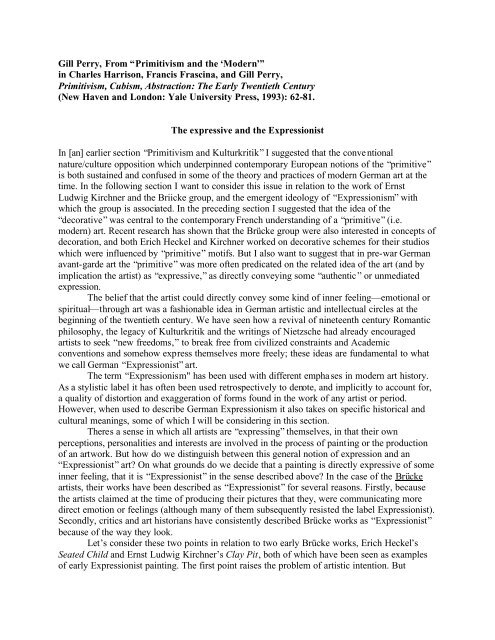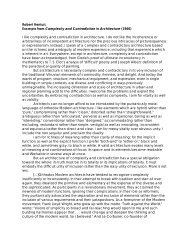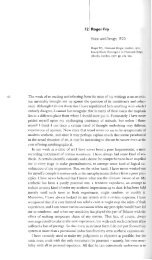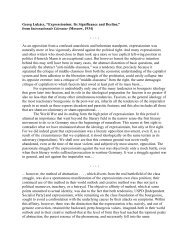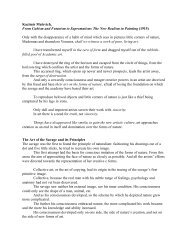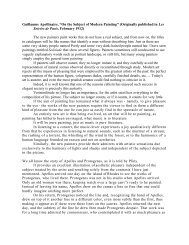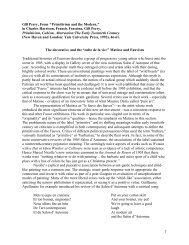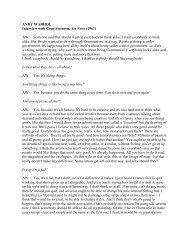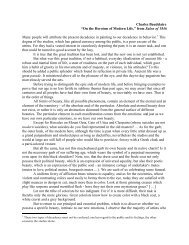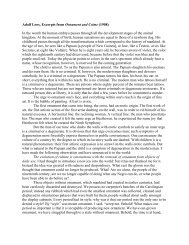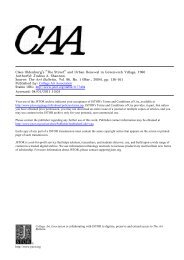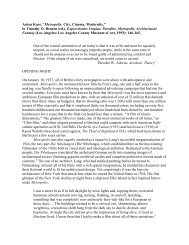Gill Perry, From “Primitivism and the 'Modern'” - Maria Elena Buszek
Gill Perry, From “Primitivism and the 'Modern'” - Maria Elena Buszek
Gill Perry, From “Primitivism and the 'Modern'” - Maria Elena Buszek
Create successful ePaper yourself
Turn your PDF publications into a flip-book with our unique Google optimized e-Paper software.
<strong>Gill</strong> <strong>Perry</strong>, <strong>From</strong> <strong>“Primitivism</strong> <strong>and</strong> <strong>the</strong> ‘Modern’”<br />
in Charles Harrison, Francis Frascina, <strong>and</strong> <strong>Gill</strong> <strong>Perry</strong>,<br />
Primitivism, Cubism, Abstraction: The Early Twentieth Century<br />
(New Haven <strong>and</strong> London: Yale University Press, 1993): 62-81.<br />
The expressive <strong>and</strong> <strong>the</strong> Expressionist<br />
In [an] earlier section <strong>“Primitivism</strong> <strong>and</strong> Kulturkritik” I suggested that <strong>the</strong> conventional<br />
nature/culture opposition which underpinned contemporary European notions of <strong>the</strong> “primitive”<br />
is both sustained <strong>and</strong> confused in some of <strong>the</strong> <strong>the</strong>ory <strong>and</strong> practices of modern German art at <strong>the</strong><br />
time. In <strong>the</strong> following section I want to consider this issue in relation to <strong>the</strong> work of Ernst<br />
Ludwig Kirchner <strong>and</strong> <strong>the</strong> Briicke group, <strong>and</strong> <strong>the</strong> emergent ideology of “Expressionism” with<br />
which <strong>the</strong> group is associated. In <strong>the</strong> preceding section I suggested that <strong>the</strong> idea of <strong>the</strong><br />
“decorative” was central to <strong>the</strong> contemporary French underst<strong>and</strong>ing of a “primitive” (i.e.<br />
modern) art. Recent research has shown that <strong>the</strong> Brücke group were also interested in concepts of<br />
decoration, <strong>and</strong> both Erich Heckel <strong>and</strong> Kirchner worked on decorative schemes for <strong>the</strong>ir studios<br />
which were influenced by “primitive” motifs. But I also want to suggest that in pre-war German<br />
avant-garde art <strong>the</strong> “primitive” was more often predicated on <strong>the</strong> related idea of <strong>the</strong> art (<strong>and</strong> by<br />
implication <strong>the</strong> artist) as “expressive,” as directly conveying some “au<strong>the</strong>ntic” or unmediated<br />
expression.<br />
The belief that <strong>the</strong> artist could directly convey some kind of inner feeling—emotional or<br />
spiritual—through art was a fashionable idea in German artistic <strong>and</strong> intellectual circles at <strong>the</strong><br />
beginning of <strong>the</strong> twentieth century. We have seen how a revival of nineteenth century Romantic<br />
philosophy, <strong>the</strong> legacy of Kulturkritik <strong>and</strong> <strong>the</strong> writings of Nietzsche had already encouraged<br />
artists to seek “new freedoms,” to break free from civilized constraints <strong>and</strong> Academic<br />
conventions <strong>and</strong> somehow express <strong>the</strong>mselves more freely; <strong>the</strong>se ideas are fundamental to what<br />
we call German “Expressionist” art.<br />
The term “Expressionism" has been used with different emphases in modern art history.<br />
As a stylistic label it has often been used retrospectively to denote, <strong>and</strong> implicitly to account for,<br />
a quality of distortion <strong>and</strong> exaggeration of forms found in <strong>the</strong> work of any artist or period.<br />
However, when used to describe German Expressionism it also takes on specific historical <strong>and</strong><br />
cultural meanings, some of which I will be considering in this section.<br />
Theres a sense in which all artists are “expressing” <strong>the</strong>mselves, in that <strong>the</strong>ir own<br />
perceptions, personalities <strong>and</strong> interests are involved in <strong>the</strong> process of painting or <strong>the</strong> production<br />
of an artwork. But how do we distinguish between this general notion of expression <strong>and</strong> an<br />
“Expressionist” art? On what grounds do we decide that a painting is directly expressive of some<br />
inner feeling, that it is “Expressionist” in <strong>the</strong> sense described above? In <strong>the</strong> case of <strong>the</strong> Brücke<br />
artists, <strong>the</strong>ir works have been described as “Expressionist” for several reasons. Firstly, because<br />
<strong>the</strong> artists claimed at <strong>the</strong> time of producing <strong>the</strong>ir pictures that <strong>the</strong>y, were communicating more<br />
direct emotion or feelings (although many of <strong>the</strong>m subsequently resisted <strong>the</strong> label Expressionist).<br />
Secondly, critics <strong>and</strong> art historians have consistently described Brücke works as “Expressionist”<br />
because of <strong>the</strong> way <strong>the</strong>y look.<br />
Let’s consider <strong>the</strong>se two points in relation to two early Brücke works, Erich Heckel’s<br />
Seated Child <strong>and</strong> Ernst Ludwig Kirchner’s Clay Pit, both of which have been seen as examples<br />
of early Expressionist painting. The first point raises <strong>the</strong> problem of artistic intention. But
<strong>Perry</strong>, <strong>“Primitivism</strong> <strong>and</strong> <strong>the</strong> ‘Modern’” (Die Brücke)<br />
because <strong>the</strong> artist claims that he is directly expressing some kind of emotion in paintings like<br />
<strong>the</strong>se it does not automatically follow that <strong>the</strong> painting <strong>the</strong>n contains some kind of fixed meaning<br />
(which is <strong>the</strong> emotion in question). On <strong>the</strong> second point (that is <strong>the</strong> issue of labeling <strong>the</strong> work<br />
according to what it looks like), we can suggest reasons why <strong>the</strong>se two paintings have been<br />
labeled Expressionist. In both works <strong>the</strong> brushwork appears crude <strong>and</strong> unfinished; individual<br />
brushstrokes are visible <strong>and</strong> seem to have been loosely applied. In addition, non-natural colours<br />
are often employed, as in <strong>the</strong> face of Heckel’s child or in Kirchner’s l<strong>and</strong>scape. As a result, <strong>the</strong><br />
subject-matter appears distorted; <strong>the</strong>re is an uncomfortable tension between <strong>the</strong> images depicted<br />
<strong>and</strong> <strong>the</strong> visible brushwork on <strong>the</strong> canvas surface. In contemporary Academic terms this mode of<br />
painting revealed a lack of competence, a crude unfinished technique. But for those who<br />
subsequently used <strong>the</strong> label “Expressionist,” it was valued according to a different criteria. It was<br />
seen to be expressive of much more than <strong>the</strong> subject-matter depicted; it was seen as clear<br />
evidence of <strong>the</strong> artist’s physical <strong>and</strong> emotional involvement with <strong>the</strong> medium, of a rejection of<br />
sophisticated forms of artistic competence in pursuit of <strong>the</strong> direct expression of <strong>the</strong> artist’s<br />
feelings or emotions onto <strong>the</strong> canvas.<br />
Clearly <strong>the</strong>se implications of <strong>the</strong> label raise some problems. Many of <strong>the</strong> technical aspects of<br />
<strong>the</strong>se works can be attributed as much to <strong>the</strong> influence of French Neo-Impressionist <strong>and</strong><br />
Impressionist techniques (such as <strong>the</strong> individual brushstrokes of bright colour) as to <strong>the</strong> artist’s<br />
“expressive urges.” And how do we distinguish between supposedly “au<strong>the</strong>ntic” expression <strong>and</strong><br />
technical incompetence? One of <strong>the</strong> problems is that many of <strong>the</strong> popular meanings of <strong>the</strong> label<br />
Expressionist which I have discussed above are untestable. They are largely based on subjective<br />
claims for what a work expresses, or on a personal response to what a work looks like. What we<br />
can do is assess <strong>the</strong> artistic <strong>and</strong> cultural context in which such art emerged, <strong>and</strong> <strong>the</strong>n try to sort<br />
out some of <strong>the</strong> more difficult or complex meanings that <strong>the</strong>se Brücke works held both for <strong>the</strong>ir<br />
contemporaries <strong>and</strong> hold for us today.<br />
In 1906 <strong>the</strong> Brücke painters, who <strong>the</strong>n included Kirchner, Heckel, Fritz Bleyl <strong>and</strong> Karl<br />
Schmidt-Rottluff, produced <strong>the</strong>ir group manifesto. It was printed in <strong>the</strong> opening pages to <strong>the</strong><br />
(incomplete) catalogue of <strong>the</strong>ir first group exhibition held in <strong>the</strong> Löbtau district of Dresden in<br />
1906:<br />
With faith in progress <strong>and</strong> in a new generation of creators <strong>and</strong> spectators we call<br />
toge<strong>the</strong>r all youth. As youth, we carry <strong>the</strong> future in us <strong>and</strong> want to create for<br />
ourselves freedom of life <strong>and</strong> of movement against <strong>the</strong> long-established older<br />
forces. We claim as our own everyone who reproduces that which drives him to<br />
creation with directness <strong>and</strong> au<strong>the</strong>nticity.<br />
There’s a sense in which this short manifesto, printed in pseudo-primitive lettering, helped to set<br />
<strong>the</strong> agenda for what is now loosely labeled an Expressionist ideology. It echoes <strong>the</strong> concerns of<br />
many contemporary artists, writers <strong>and</strong> intellectuals who, during <strong>the</strong> pre-war period saw <strong>the</strong>ir<br />
work as a radical alternative to bourgeois culture <strong>and</strong> its values. According to <strong>the</strong> few surviving<br />
letters <strong>and</strong> documents <strong>the</strong> Brücke notion of progress was inseparable from a muddled sense of<br />
rebellion against industrialized bourgeois society. It was steeped in Nietzschean ideas of <strong>the</strong> need<br />
to destroy sterile middle-class values in order to facilitate an artistic renewal, to enable new<br />
forms of creative expression.<br />
For many artists <strong>and</strong> writers Nietzsche’s writings offered quasi-philosophical solutions<br />
<strong>and</strong> alternatives to contemporary currents of anti-materialism <strong>and</strong> religious skepticism, solutions<br />
2
<strong>Perry</strong>, <strong>“Primitivism</strong> <strong>and</strong> <strong>the</strong> ‘Modern’” (Die Brücke)<br />
which placed special emphasis on <strong>the</strong> role of <strong>the</strong> “individual” <strong>and</strong> <strong>the</strong> artist in seeking out<br />
creative freedoms. Despite some of <strong>the</strong> contradictions in his writings (produced during <strong>the</strong> years<br />
1872-88) “modernity” is consistently associated with cultural decadence, which is to be<br />
overcome by a dialectical process of “re-valuation” <strong>and</strong> “selfovercoming” (see, for example<br />
Beyond Good <strong>and</strong> Evil <strong>and</strong> The Case of Wagner). What is involved in <strong>the</strong>se processes is<br />
explored in Thus Spake Zarathustra (published in parts in <strong>the</strong> 1890s), a book regularly cited by<br />
members of <strong>the</strong> early Brücke group to justify <strong>the</strong>ir declared attitudes to art. In it Nietzsche uses<br />
<strong>the</strong> figure of Zarathustra to explore <strong>and</strong> counter modern cultural conditioning. He declares <strong>the</strong><br />
death of religion <strong>and</strong> <strong>the</strong> loss of conventional “meaning” of life (in <strong>the</strong> sense of supernatural<br />
purpose), advocating an attempt to “overcome” this conditioning, to seek out o<strong>the</strong>r forms of<br />
expression <strong>and</strong> meaning. Zarathustra calls <strong>the</strong> man who has overcome <strong>the</strong>se forces of decadence<br />
<strong>the</strong> Obermensch (overperson or overman), an idea subsequently popularized by Bernard Shaw’s<br />
somewhat ironic translation of “superman” (Nietzsche’s texts are exclusively addressed to men,<br />
who are seen by him as <strong>the</strong> agents of cultural change). The idea that <strong>the</strong> individual could<br />
overcome <strong>the</strong> constrictions of a culture was irresistible to <strong>the</strong> early Brücke artists, who probably<br />
took <strong>the</strong>ir group name from Thus Spake Zarathustra. The metaphor of <strong>the</strong> bridge (die Brücke) is<br />
used by Zarathustra in <strong>the</strong> book to represent man’s journey from absorption in a decadent culture<br />
to a state of freedom <strong>and</strong> “overcoming.” In <strong>the</strong> prologue Neitzsche writes in his characteristically<br />
epigrammatic style:<br />
What is great in man is that he is a bridge <strong>and</strong> not an end: what can be loved in<br />
man is that he is an overture <strong>and</strong> a going under ...<br />
I love him who does not hold back one drop of spirit for himself, but wants to be<br />
entirely <strong>the</strong> spirit of his virtue: thus he strides over <strong>the</strong> bridge as spirit<br />
The bridge <strong>the</strong>n could symbolize <strong>the</strong> group’s journey towards, <strong>and</strong> pursuit of, “new freedoms.”<br />
For <strong>the</strong> Brücke group this idea of rebellion is inextricably tied up with an underst<strong>and</strong>ing of <strong>the</strong><br />
value of “primitive” sources. The group’s interest in <strong>the</strong>se sources, many of which came from <strong>the</strong><br />
Dresden Ethnographical Collections, was predicated on <strong>the</strong> belief that <strong>the</strong>se were “truthful”<br />
unsophisticated forms of art, uncorrupted by modern bourgeois culture. And <strong>the</strong> evidence for this<br />
lay partly in <strong>the</strong> ‘seemingly unsophisticated) distortions <strong>and</strong> simplifications which <strong>the</strong>y observed<br />
in “primitive” artifacts. They could thus be identified with what <strong>the</strong> manifesto calls<br />
“au<strong>the</strong>nticity” (Unverfälscht). Similarly, this “new generation of creators” is laying claim to a<br />
new more direct mode of creation, a form of expression which can somehow deny its<br />
conditioning in <strong>the</strong> way that Nietzsche’s Obermensch overcame his decadent culture.<br />
The manifesto tells us that this more “au<strong>the</strong>ntic” mode of expression was also seen as <strong>the</strong><br />
prerogative of youth. The founder members of <strong>the</strong> Brücke were architectural students studying at<br />
<strong>the</strong> Sächsische Technische Hochschule. As students, all in <strong>the</strong>ir early twenties, <strong>the</strong>y shared a<br />
sense of youthful rebellion. For <strong>the</strong> Brucke, as for many o<strong>the</strong>r Germans at <strong>the</strong> time, youth was<br />
seen as <strong>the</strong> vehicle of less corrupt modes of expression, <strong>and</strong> as st<strong>and</strong>ing in <strong>the</strong> front line of attack<br />
against prevailing bourgeois values.<br />
It is important to qualify this notion of rebellion <strong>and</strong> its implications for a supposedly<br />
radical or “modern” art. In turn-of-<strong>the</strong>-century Germany, to be against modern bourgeois culture<br />
often meant little more than to be against modern industrial society <strong>and</strong> aspects of urban life,<br />
especially petty bourgeois commercialism <strong>and</strong> its associated values. Thus in 1934 <strong>the</strong> Hungarian<br />
writer Georg Lukács described “<strong>the</strong> complete emptying of <strong>the</strong> concept of ‘revolution’ among<br />
3
<strong>Perry</strong>, <strong>“Primitivism</strong> <strong>and</strong> <strong>the</strong> ‘Modern’” (Die Brücke)<br />
Expressionists.” The early Brücke group were idealistic young students with controversial <strong>and</strong><br />
anti-establishment views, but <strong>the</strong>re is no evidence that <strong>the</strong>y adopted coherent political positions<br />
or belonged to any left-wing political movements. But as we have seen, <strong>the</strong>ir ideas were not<br />
exclusively tied to <strong>the</strong>ories of artistic expression. For <strong>the</strong> Brücke artists <strong>the</strong>y were expressed <strong>and</strong><br />
developed in an attempted fusion of art <strong>and</strong> life. In both <strong>the</strong>ir social activities <strong>and</strong> in <strong>the</strong>ir painted<br />
<strong>and</strong> graphic work <strong>the</strong> group set about undermining contemporary bourgeois sexual mores, <strong>and</strong> a<br />
revaluation of “primitive” sources <strong>and</strong> lifestyles (largely African, Oceanic <strong>and</strong> Medieval).<br />
Contemporary discourses on sexuality, like those on <strong>the</strong> meaning <strong>and</strong> value of <strong>the</strong> “primitive”,<br />
were <strong>the</strong> focus of much cultural <strong>and</strong> political debate in Germany at <strong>the</strong> time. How far <strong>the</strong>se<br />
interests were, or could be embodied in Brücke art will form one of <strong>the</strong> <strong>the</strong>mes of <strong>the</strong> following<br />
section.<br />
Expression <strong>and</strong> <strong>the</strong> body<br />
One of <strong>the</strong> subjects which predominates in Brücke painted <strong>and</strong> graphic work was <strong>the</strong> female <strong>and</strong>,<br />
on occasion, <strong>the</strong> male nude. This preoccupation owed much to Jugendstil art interests, in which<br />
<strong>the</strong> <strong>the</strong>me of <strong>the</strong> nude came to represent a wide range of decorative, symbolic <strong>and</strong> cultural<br />
interests. For <strong>the</strong> Brücke artists, <strong>the</strong> nude female body in particular became a central motif, laden<br />
with various literal <strong>and</strong> symbolic meanings. In singling out <strong>the</strong> repetition of this subject-matter I<br />
am, of course, developing a <strong>the</strong>me explored earlier in this essay, <strong>the</strong> implicit <strong>and</strong> explicit<br />
association often made in Western art <strong>and</strong> culture between <strong>the</strong> female nude <strong>and</strong> <strong>the</strong> “primitive,”<br />
between woman <strong>and</strong> nature, by contrast with a more masculine “culture” or, in this context,<br />
Zivilisation. But I want to argue that in Brücke work <strong>the</strong> nude also becomes <strong>the</strong> symbolic focus<br />
of a wider range of interests <strong>and</strong> debates, both cultural <strong>and</strong> aes<strong>the</strong>tic. These include <strong>the</strong> groups”<br />
claims for technical radicalism, for sexual liberation <strong>and</strong> antibourgeois activities, <strong>and</strong> for more<br />
“au<strong>the</strong>ntic” modes of social <strong>and</strong> artistic expression. I want to look at some of <strong>the</strong> slippages <strong>and</strong><br />
displacements of those symbolic meanings which I believe are suggested in several Brücke<br />
paintings of <strong>the</strong> nude <strong>the</strong>me from <strong>the</strong> period c.1909-1916.<br />
Around 1910 Kirchner produced several nudes in interiors which seem to raise questions<br />
about meaning <strong>and</strong> symbolic function. Reclining Nude in Front of a Mirror, Ba<strong>the</strong>rs in a Room,<br />
<strong>and</strong> St<strong>and</strong>ing Nude with a Hat were all painted during <strong>the</strong> period 1909-10, although <strong>the</strong> Ba<strong>the</strong>rs<br />
in a Room was reworked in 1920 (in <strong>the</strong> 1920s Kirchner reworked many paintings from this prewar<br />
period). Each of <strong>the</strong>se works is painted in a style ra<strong>the</strong>r different from <strong>the</strong> freely applied<br />
brushwork <strong>and</strong> vibrating surface effects of <strong>the</strong> earliest Brücke paintings. Although <strong>the</strong>re are areas<br />
of loose brushwork, <strong>the</strong> paint seems to have been applied in flatter areas with forms reduced to<br />
more angular, almost spiky shapes, a style influenced by <strong>the</strong> techniques of <strong>the</strong> woodcut medium<br />
which <strong>the</strong> Brücke artists were using extensively at <strong>the</strong> time. The use of vibrant, often non-natural<br />
color, as in <strong>the</strong> lurid green body of <strong>the</strong> Reclining Nude, contributes to <strong>the</strong> sense of distortion <strong>and</strong><br />
awkwardness conveyed by most of <strong>the</strong>se nudes. Technically at least, <strong>the</strong>se works could be read<br />
as a rejection of <strong>the</strong> conventions <strong>and</strong> competences associated with two str<strong>and</strong>s of contemporary<br />
German painting: <strong>the</strong> Courbet-influenced school of naturalist painters (which included many of<br />
<strong>the</strong> Worpswede painters) <strong>and</strong> <strong>the</strong> so-called German Impressionists (notably Liebermann, Corinth<br />
<strong>and</strong> Slevogt). Around <strong>the</strong> turn of <strong>the</strong> century both broad groups had laid claim to radical<br />
objectives <strong>and</strong> a shared opposition to Wilhelmine Academicism.<br />
The relative technical radicalism of <strong>the</strong>se Brücke works draws on ano<strong>the</strong>r source:<br />
“primitive” <strong>and</strong> exotic artifacts <strong>and</strong> designs. The decorative motifs in <strong>the</strong> drapes <strong>and</strong> background<br />
of <strong>the</strong> Ba<strong>the</strong>rs in a Room <strong>and</strong> <strong>the</strong> St<strong>and</strong>ing Nude are influenced by African <strong>and</strong> Oceanic objects<br />
4
<strong>Perry</strong>, <strong>“Primitivism</strong> <strong>and</strong> <strong>the</strong> ‘Modern’” (Die Brücke)<br />
available in <strong>the</strong> Dresden Ethnographical Museum, including carved <strong>and</strong> painted house beams<br />
from <strong>the</strong> Palau Isl<strong>and</strong>s, a German colony in <strong>the</strong> South Seas. Such references, however vague <strong>and</strong><br />
unspecific, would have been recognized by contemporary viewers as an indication of <strong>the</strong><br />
paintings” “modern” qualities, of <strong>the</strong> explicit association of Kirchner’s work with artifacts<br />
deemed to be <strong>the</strong> product of “uncivilized” <strong>and</strong> <strong>the</strong>refore more “au<strong>the</strong>ntic” expression.<br />
As in France, <strong>the</strong> growth of artistic interest in “primitive” or tribal objects coincided with<br />
<strong>the</strong> founding <strong>and</strong> expansion of German ethnographical collections around <strong>the</strong> end of <strong>the</strong><br />
nineteenth century. During this period German colonial acquisitions in Africa <strong>and</strong> more<br />
importantly Oceania, <strong>and</strong> <strong>the</strong> political <strong>and</strong> economic competition for world markets which<br />
accompanied it, were represented by <strong>the</strong> founding of ethnographical collections in Berlin,<br />
Hamburg, Leipzig <strong>and</strong> Dresden. Public exhibitions of colonial art became increasingly popular<br />
<strong>and</strong> Dresden hosted a series of shows of “primitive” <strong>and</strong> “exotic” cultures which began in 1909.<br />
These included an African village <strong>and</strong> dancers, shown in <strong>the</strong> Dresden zoological gardens in<br />
1910, on which Heckel <strong>and</strong> Kirchner reported with enthusiasm.<br />
As with contemporary French readings of African <strong>and</strong> non-European works, <strong>the</strong> idea that<br />
objects in museum collections <strong>and</strong> contemporary exhibitions were somehow more<br />
“au<strong>the</strong>ntic” forms of expression was, of course, part of a Western fantasy of “primitive” culture,<br />
which gave meaning to - or could be identified with - its own “modern” modes of artistic<br />
expression. But at <strong>the</strong> same time this alien culture was also represented as <strong>the</strong> “o<strong>the</strong>r” of civilized<br />
Western culture. In <strong>the</strong> German context, <strong>the</strong> Nietzschean notion that “genius resides in instinct”<br />
(Will to Power), in unfettered personal expression, was easily projected onto works which were<br />
thought to be <strong>the</strong> products of a less civilized <strong>and</strong> <strong>the</strong>refore more instinctive culture.<br />
However, references to supposedly “primitive” techniques <strong>and</strong> sources contribute only a<br />
part of <strong>the</strong> possible meanings of <strong>the</strong>se paintings. The Ba<strong>the</strong>rs in a Room is a large canvas (151 x<br />
198 cm) which reworks an established art-historical <strong>the</strong>me. Kirchner’s nude women assume<br />
graceful poses reminiscent of many Symbolist ba<strong>the</strong>rs, <strong>and</strong> of Matisse’s pastoral compositions.<br />
Yet <strong>the</strong>re are several aspects which confuse <strong>the</strong> art-historical precedents. The ba<strong>the</strong>rs <strong>the</strong>me is<br />
conventionally associated with an outdoor setting—<strong>the</strong> nude in nature—but <strong>the</strong>se women are<br />
contained within an artificial interior space, albeit one decorated with pseudo-primitive designs<br />
<strong>and</strong> carvings. In spite of <strong>the</strong> indolent pastoral poses, o<strong>the</strong>r aspects—<strong>the</strong> use of greenish tones, <strong>the</strong><br />
distortions <strong>and</strong> angularities in some of <strong>the</strong> bodies <strong>and</strong> <strong>the</strong>ir positions in relation to <strong>the</strong> decorative<br />
surround—draw <strong>the</strong> viewer’s attention to <strong>the</strong> artifice of painting, to <strong>the</strong> complex processes of<br />
representation, ra<strong>the</strong>r than to its potential as instinctive expression. This emphasis is reinforced<br />
by <strong>the</strong> inclusion both of a painting within a painting at <strong>the</strong> back of <strong>the</strong> bedroom annex in <strong>the</strong><br />
centre, <strong>and</strong> by what seems to be a deliberate ambiguity in <strong>the</strong> painting of <strong>the</strong> annex. The scale of<br />
<strong>the</strong> reclining woman on <strong>the</strong> bed does not quite seem to fit her position at <strong>the</strong> back of <strong>the</strong> scene.<br />
And <strong>the</strong> opening with its carved door jambs also serves as a frame for this nude, in her reclining<br />
odalisque pose. Thus this figure can also be read as a fictional painting within a painting, an<br />
ambivalence which is reinforced by <strong>the</strong> inclusion of a fictional painting on <strong>the</strong> wall behind her.<br />
While it’s impossible to prove that this pictorial ambivalence was intended by <strong>the</strong> artist, <strong>the</strong><br />
likelihood that Kirchner was concerned with <strong>the</strong> nude both as a symbol of “primitive”<br />
associations <strong>and</strong> as a problematic image in <strong>the</strong> history of representation, is also suggested by<br />
o<strong>the</strong>r works from this period. The Reclining Nude in front of a Mirror reworks <strong>the</strong> art-historical<br />
<strong>the</strong>me made famous by Velasquez’s Rokeby Venus (late 1640s) in which <strong>the</strong> female nude<br />
reclines holding a mirror to her face. We are invited to gaze both at <strong>the</strong> body <strong>and</strong> its mirror<br />
image. Yet in Kirchner’s work <strong>the</strong>re is once again a seemingly deliberate pictorial ambivalence:<br />
5
<strong>Perry</strong>, <strong>“Primitivism</strong> <strong>and</strong> <strong>the</strong> ‘Modern’” (Die Brücke)<br />
<strong>the</strong> mirror image does not quite match <strong>the</strong> pose or <strong>the</strong> distortions of <strong>the</strong> body which it supposedly<br />
reflects. It seems to function both as a mirror image <strong>and</strong> as ano<strong>the</strong>r painting of a nude within a<br />
painting of a nude.<br />
Kirchner’s St<strong>and</strong>ing Nude with Hat also plays on art-historical precedents. The pose,<br />
necklace <strong>and</strong> shape of <strong>the</strong> body are influenced by Cranach’s Venus of 1532. However, Kirchner’s<br />
reworking of this <strong>the</strong>me helped to produce an image which contemporary German viewers would<br />
have found hard to read. The “primitive” references in <strong>the</strong> background seem to jar with <strong>the</strong><br />
sophisticated, urban nature of <strong>the</strong> nude. She is naked yet heavily made up, wears jewelry, a<br />
fashionable hat <strong>and</strong> shoes. Much like Manet’s Olympia of fifty years earlier, her nudity is not of<br />
<strong>the</strong> conventional odalisque kind; she carries evidence of her sophisticated, possibly morally<br />
corrupt life. Prostitution, dancing <strong>and</strong> modeling were <strong>the</strong> “careers” implicated by her fashionable<br />
state of undress. This implied public invasion of feminine privacy is fur<strong>the</strong>r suggested by <strong>the</strong><br />
starkly painted pubic hair which has been shaved into a triangle shape, a fashion at <strong>the</strong> time<br />
among dancers. Moreover she is shown st<strong>and</strong>ing <strong>and</strong> engages <strong>the</strong> viewer with her eyes, ra<strong>the</strong>r<br />
than passively reclining as <strong>the</strong> object of his gaze. For <strong>the</strong> contemporary German audience for<br />
whom <strong>the</strong> nudes of Impressionist painters such as Corinth still held some progressive or<br />
“modern” status, Kirchner s St<strong>and</strong>ing Nude posed some problems of interpretation <strong>and</strong> meaning.<br />
The sexual connotations of Kirchner’s work also contributed to its controversial<br />
“modern” status. The model was <strong>the</strong> artist’s girlfriend, <strong>the</strong> dancer Doris Grohse, <strong>and</strong> <strong>the</strong> Brücke<br />
group’s overt association with <strong>the</strong> world of dancers, prostitutes <strong>and</strong> performers, who were often<br />
<strong>the</strong> subjects of <strong>the</strong>ir works, was a part of <strong>the</strong>ir sexual revolution. Sexuality, <strong>and</strong> its representation<br />
in both female <strong>and</strong> male subjects, was central to <strong>the</strong>ir notion of free self-expression, as was <strong>the</strong>ir<br />
association with various forms of modern dance. <strong>From</strong> <strong>the</strong> bourgeois point of view such open<br />
sexuality, associated with social groups such as prostitutes, bohemians <strong>and</strong> dancers, was<br />
condemned as decadent or deviant. In his works Kirchner often combined overt references to this<br />
“decadent” sexuality, with references to a more “primitive” sexuality. In <strong>the</strong> Ba<strong>the</strong>rs for<br />
example, <strong>the</strong> drapes which protect <strong>the</strong> room to <strong>the</strong> left contain figure groups in <strong>the</strong> roundels,<br />
including couples making love. Similar drapes decorated with scenes of copulating couples<br />
appear in <strong>the</strong> background of o<strong>the</strong>r works from this period, including Girl under Japanese<br />
Umbrella, <strong>and</strong> were probably based on painted drapes in Kirchner’s own studio. They were<br />
influenced by erotic scenes on carved <strong>and</strong> painted house beams from <strong>the</strong> Palau Isl<strong>and</strong>s which<br />
Kirchner saw in <strong>the</strong> Dresden Museum.<br />
The overtly sexual imagery on <strong>the</strong>se beams <strong>and</strong> o<strong>the</strong>r African <strong>and</strong> Oceanic sources also<br />
encouraged prevalent Western myths about black sexuality, “natural rhythms,” <strong>and</strong> instinctive<br />
expression. Such myths are evoked, or at least suggested, in Kirchner’s use of male <strong>and</strong> female<br />
negro dancers <strong>and</strong> models in his works from around 1909-11. And in a now famous studio<br />
photograph he combined <strong>the</strong> “primitive” with its painted representation when he posed his black<br />
models Sam <strong>and</strong> Milli in <strong>the</strong> nude amidst <strong>the</strong> same decorative drapes as those depicted in <strong>the</strong><br />
background of <strong>the</strong> Ba<strong>the</strong>rs.<br />
For Kirchner in particular, <strong>the</strong> representation of <strong>the</strong> nude was a potential weapon in <strong>the</strong><br />
refutation of contemporary bourgeois sexual mores. I am not arguing, however, that through his<br />
work Kirchner was somehow able to escape a prevalent system of Eurocentric values through<br />
which both black people <strong>and</strong> nude women came to symbolize some fantasy of free “primitive”<br />
expression His liberal sexuality also reinforced Western myths. 1 am suggesting ra<strong>the</strong>r that when<br />
this primitivism was combined with a visible concern with <strong>the</strong> technical <strong>and</strong> art-historical<br />
problems of representation, he could on occasion produce works which upset contemporary<br />
6
<strong>Perry</strong>, <strong>“Primitivism</strong> <strong>and</strong> <strong>the</strong> ‘Modern’” (Die Brücke)<br />
artistic expectations, <strong>and</strong> which cannot be read easily in terms of a crude nature/ culture<br />
opposition.<br />
In some ways this opposition is more easily read into <strong>the</strong> many nudes in nature <strong>and</strong> ba<strong>the</strong>r<br />
subjects produced by members of <strong>the</strong> Briicke group between c.1909 <strong>and</strong> 1914. For example, <strong>the</strong><br />
association between nude woman, <strong>the</strong> “primitive” <strong>and</strong> nature is made explicitly <strong>and</strong> (I would<br />
argue) somewhat crudely, in Heckel’s famous Day of Glass. In this work, woman is shown<br />
naked against an awesome nature of snowy mountain peaks, reflected in a lake. Her arms are<br />
raised to display a body painted to resemble an African sculpture. She has a pot belly, pendulous<br />
breasts <strong>and</strong> partly visible face. Denied recognizable features, she functions as both a literal <strong>and</strong><br />
symbolic representation of <strong>the</strong> “primitive,” of “woman as nature.”<br />
Yet <strong>the</strong>re are several ba<strong>the</strong>rs subjects from around <strong>the</strong> same period in which <strong>the</strong> symbolic<br />
meanings are less clear cut. During <strong>the</strong> summers of 1909, 1910 <strong>and</strong> 1911 members of <strong>the</strong> group,<br />
accompanied by girlfriends <strong>and</strong> models (often including Sam <strong>and</strong> Milli) made regular<br />
expeditions to <strong>the</strong> Moritzburg lakes, in <strong>the</strong> countryside north of Dresden, <strong>and</strong> within easy reach<br />
of <strong>the</strong> town by train. On <strong>the</strong>se expeditions, <strong>the</strong>y would often ba<strong>the</strong>, sunba<strong>the</strong> <strong>and</strong> sketch in <strong>the</strong><br />
nude. Thus <strong>the</strong> Moritzburg paintings represent both a record of those summer activities <strong>and</strong> a<br />
critical engagement with a long-established art-historical <strong>the</strong>me.<br />
Paintings such as Kirchner’s Ba<strong>the</strong>rs at Moritzburg or Heckel’s Ba<strong>the</strong>rs (Plates 61, 75)<br />
show both men <strong>and</strong> women bathing naked <strong>and</strong> participating in nudist cults (Nacktkultur or<br />
Freikörperkultur) which were especially popular among <strong>the</strong> younger generation in Germany at<br />
<strong>the</strong> time. Such cults were often associated with vegetarianism, dress reform <strong>and</strong> nature cures, <strong>and</strong><br />
fed into early Expressionist ideas of direct <strong>and</strong> unsophisticated expression. Although Naturism<br />
<strong>and</strong> nudist cults tended to be represented as “alternative” movements <strong>the</strong>ir political associations<br />
were often contradictory, for <strong>the</strong>y attracted both progressive <strong>and</strong> conservative supporters,<br />
reinforcing once again <strong>the</strong> confusing political sources of Expressionist ideology.<br />
It is no coincidence that <strong>the</strong> Brücke group emerged in Dresden, a town <strong>the</strong>n famous for<br />
its provision of sanatoria <strong>and</strong> health resorts, promoting a culture of natural medicine <strong>and</strong> bodily<br />
revitalization through nudity. Sexual freedom was more often than not a part of this culture of<br />
<strong>the</strong> body. Like <strong>the</strong> experience of nudity within nature, open expressions of sexuality <strong>and</strong><br />
eroticism were seen to be tapping <strong>the</strong> more instinctive needs of <strong>the</strong> individual. Thus many of <strong>the</strong><br />
Moritzburg sketches <strong>and</strong> paintings show naked couples, often in erotic poses. The <strong>the</strong>me of <strong>the</strong><br />
naked couple <strong>and</strong> <strong>the</strong> frequent inclusion of male nudes, often with <strong>the</strong>ir sexual organs clearly<br />
displayed, did not conform to some of <strong>the</strong> historical conventions for <strong>the</strong> ba<strong>the</strong>rs <strong>the</strong>me. Moreover<br />
<strong>the</strong> sexual implications would have been read by some as a defiant refusal of contemporary<br />
bourgeois sexual mores.<br />
The Ba<strong>the</strong>rs at Moritzburg was probably intended as a companion piece to <strong>the</strong> Ba<strong>the</strong>rs in<br />
a Room. It is identical in size (151 x 199cm), <strong>and</strong> was repainted around <strong>the</strong> same time. Given<br />
<strong>the</strong>se dimensions, it is reasonable to presume that both works were intended as “modern”<br />
statements on a gr<strong>and</strong> scale. The tension between <strong>the</strong> epic pretensions of such large scale<br />
canvases, <strong>and</strong> <strong>the</strong> unconventional reworkings of <strong>the</strong> ba<strong>the</strong>rs <strong>the</strong>me evident in each canvas, is still<br />
accessible to a modern audience. Although <strong>the</strong> Moritzburg work is out of doors, <strong>the</strong> crude<br />
distortions, <strong>the</strong> use of greenish skin color (perhaps intended as a literal association with <strong>the</strong> green<br />
of nature?) <strong>and</strong> <strong>the</strong> combination of full frontal male <strong>and</strong> female nudity do not fit even with<br />
Cezannesque conventions for <strong>the</strong> ba<strong>the</strong>rs <strong>the</strong>me, which were <strong>the</strong>n regarded in France <strong>and</strong><br />
Germany as progressive interpretations of <strong>the</strong> subject. The technical distortions <strong>and</strong> angularities,<br />
7
<strong>Perry</strong>, <strong>“Primitivism</strong> <strong>and</strong> <strong>the</strong> ‘Modern’” (Die Brücke)<br />
<strong>the</strong> crowding of figures to <strong>the</strong> left of <strong>the</strong> canvas, seem, moreover, to undermine <strong>the</strong> pastoral<br />
associations which are sustained in, for example, many of Matisse’s reworkings of <strong>the</strong> <strong>the</strong>me.<br />
Brücke primitivism, <strong>the</strong>n, could be double edged. The interpretations of <strong>the</strong> imagery of<br />
ba<strong>the</strong>rs which recur in pre-war painted <strong>and</strong> graphic work by <strong>the</strong> group, seem to reinforce <strong>the</strong><br />
nature-culture opposition central to contemporary Expressionist <strong>the</strong>ory. On <strong>the</strong> o<strong>the</strong>r h<strong>and</strong>, I have<br />
suggested that, in Kirchner’s work in particular, some of <strong>the</strong> pictorial conventions associated<br />
with <strong>the</strong> representation of woman in nature are critically analyzed - or at least reworked - <strong>and</strong><br />
take on different meanings. Kirchner’s deliberate combination of <strong>the</strong> sophisticated <strong>and</strong> urban<br />
with “primitive” <strong>and</strong> tribal imagery, of female <strong>and</strong> male nudity, contribute to this reworking of<br />
conventions. In some of <strong>the</strong> paintings discussed I suggested that <strong>the</strong> use of technical distortions,<br />
spatial confusion, <strong>and</strong> <strong>the</strong> play on conventions for <strong>the</strong> representation of <strong>the</strong> nude, contribute to a<br />
pictorial ambivalence, focusing our attention both on issues of pictorial representation, <strong>and</strong> on<br />
<strong>the</strong> modern associations of a supposedly “primitive” subject-matter.<br />
8


